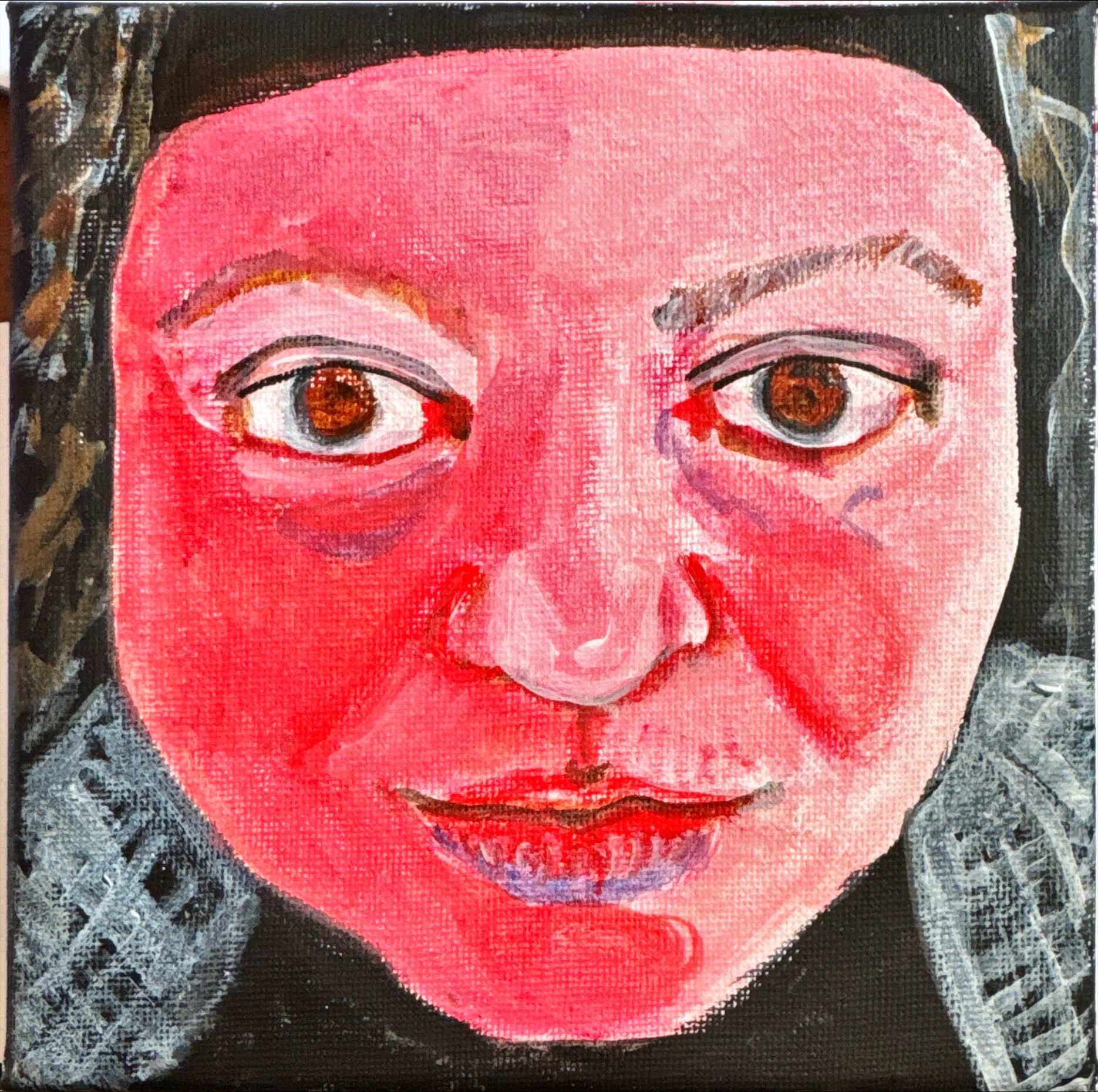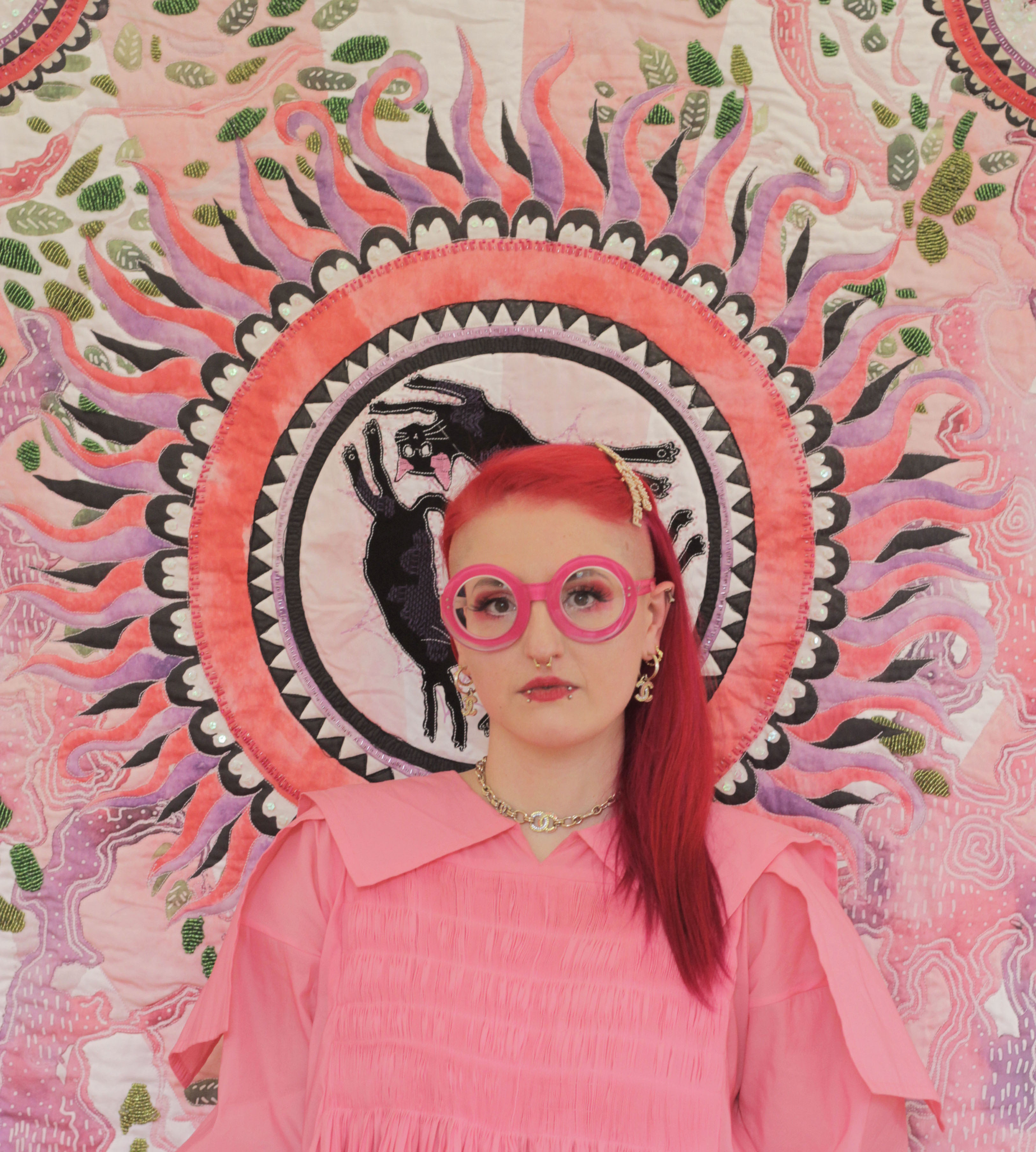Real Lemon
Real Lemon: An Intergenerational Dialogue on Lesbian Tradition
Interview by Sarah-Joy Ford With Rachael Field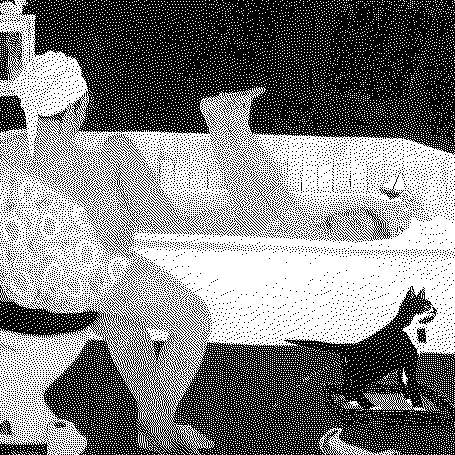
Abstract
This interview presents an illustrated intergenerational conversation between the lesbian artists Rachael Field and Sarah-Joy Ford. The two Manchester-based queer artists reflect on the significance of Field’s 1991 solo show Real Lemon: Broadening Out, held at Rochdale Art Gallery, which they revisit in the context of A Tall Order!, an exhibition that looked back at programming at Touchstones (then Rochdale Art Gallery) in the 1980s and 1990s. They also discuss Ford’s commissioned work for A Tall Order!, a textile installation that references and responds to Field’s painting Domestic Scene Whalley Range (1991), first exhibited in Real Lemon. Through a discussion of archival materials, artistic practice, and exhibitions, Field and Ford explore the past and present of lesbian art history in Britain since the 1990s.
Introduction
This interview took place in March 2024, and presents an illustrated intergenerational conversation between the lesbian artists Rachael Field and Sarah-Joy Ford, shared over cups of tea in Field’s front room, surrounded by paintings, drawings, and sketchbooks.
The two Manchester-based queer artists discuss their friendship and fortuitous meeting through, and involvement with, the exhibition A Tall Order!, curated by Derek Horton and Alice Correia at Touchstones in 2023. The exhibition was a large-scale group show that looked back at the daring programming of the 1980s and early 1990s led by the exhibition officer Jill Morgan, and that focused on exhibiting under-represented artists engaged in critical and sociopolitical practice, many of whom were young, working class, black and/or LGBTQIA+. It brought many of these artists back into dialogue, including Sutapa Biswas, Veronica Slater, Sonia Boyce, Lubaina Himid, Chila Kumari Burman, Keith Piper, and Ingrid Pollard. It also included newly commissioned work from the next generation of artists working within these legacies by Lubna Chowdhary, Jade Montserrat, and Sarah-Joy Ford.
The conversation reflects on the significance of Field’s 1991 solo show at Touchstones, Real Lemon: Broadening Out, which presented a huge body of brightly coloured oil paintings depicting the quotidian pleasures of lesbian life both at home and in the streets. These works explicitly expressed resistance to the homophobic censorship of Section 28, the infamous Thatcherite legislation that prohibited the promotion of homosexuality as “a pretended family relationship” by councils and schools between 1988 and 2003.
The discussion is viewed through the queer archival lens of Ford’s textile installation Domestic Scene Chorlton, which was commissioned for A Tall Order! The quilted artwork in the installation directly references Field’s own painting Domestic Scene Whalley Range (1991), offering an intergenerational mirroring of an intimate lesbian domestic scene. Underneath the double-sided quilt was a bath belonging to the Rochdale industrialist John Bright, in a tongue-in-cheek reference to Field’s painting on a shower curtain You Ought to Be Hosed Down (1991), which was exhibited at Castlemilk Womanhouse in Glasgow in 1991. To the side was a black fossil table containing archive materials relating to Real Lemon that were also from the Rochdale Local Studies Collection. Through the recontextualisation of these archival materials, the installation wove together the past and present of lesbian art history with the local history of Rochdale.
Interview
Sarah-Joy Ford: Rachael, let’s set the scene. Can you tell me a bit about who you are and what you do?
Rachael Field: I’m an artist whose work has often explored lesbian identity. I also focus on mental health because I’m bipolar. I’m also fat, so I do stuff about that as well. One of my portraits is called Fat, Gay and Mad and that really sums me up!
SJF: A most brilliant introduction to your work!
RF: From the early 1980s to the late 1990s my work focused on lesbian representation in paint, and then diversified out into digital art and performance. But now I am returning to my roots.
SJF: I am also an artist—working mostly in textiles—and still very much in my lesbian representation era. We were brought together through an exhibition called A Tall Order!, which was curated by Derek Horton and Alice Correia at Touchstones Rochdale (Rochdale Art Gallery until 2003) in 2023. Derek approached me about the commission by handing me the catalogue for Real Lemon: Broadening Out, your 1991 solo show at Rochdale Art Gallery. Rachael, could you tell me a bit about Real Lemon?
RF: It was called Real Lemon: Broadening Out because “lemon” is a word that lesbians are called in the North (fig. 1). I don’t know if it’s universal, but “Are you a lemon, Miss?” was something you were asked when people were unsure about your identity. And Broadening Out was about my size but also to do with the idea of pushing the boundaries of lesbian art. I had finished college in 1986, and Jill Morgan had come on a studio visit and commissioned new work for my solo show. I started work on a series of large-scale paintings I called “lesbian icons”, because they were inspired by medieval portraiture—playing with perspective and flattening things out.
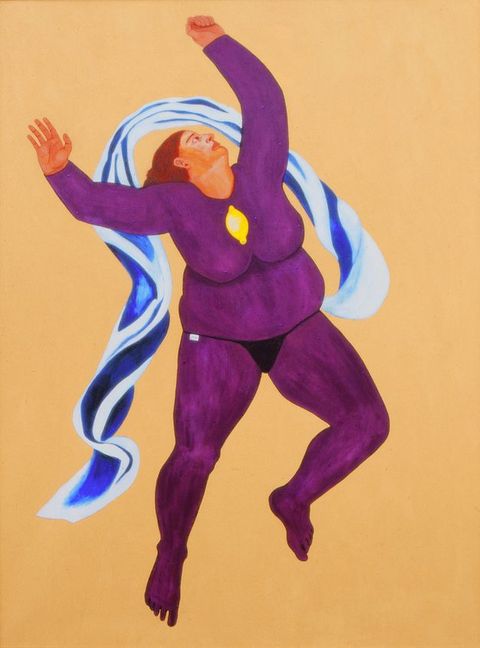
SJF: So, was working big a significant part of this work?
RF: Yes, so it was funny when I went to exhibit in Bilderschel Hamburg, which was a Hamburg lesbian-only space. An audience member said, “They’re such big paintings and they say so little”.
[Both laugh]
SJF: Savage!
RF: I know! I look back at them now and think I wouldn’t quite do them the same because it was very much a young person’s art, you know: boldly going where no person’s been before. I was using myself and my own life as subjects because I think, in a way, you can only use your own material for art.
SJF: So, there’s a lot of scenes from your everyday life?
RF: Yeah, pictures depicting me and my partner at the time, Nenagh. Us in our bathroom, our pets: our life. There’s one I really love which is called Illegal on the Street depicting when we went on a gay rally in London (fig. 2). The police were picking us off around the edges of the gathering for “public disturbance”, that is, being lesbian, gay, or queer. Another painting depicted me and Nenagh being shouted at by a lorry driver. So, there’s quite a few pictures of oppression, as well as one of me signing on for the dole called Hidden Talents because it wasn’t easy to make a living as an artist and a lesbian.
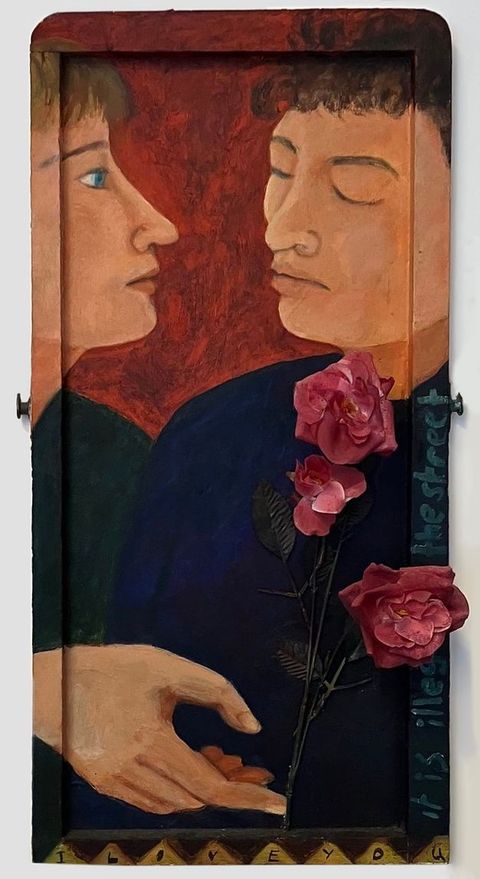
SJF: Something I really love about the paintings is the tracing of how the lesbian body is situated within public and private space, which leads me to ask about a particular painting that is very important to our story here: Domestic Scene Whalley Range (fig. 3).
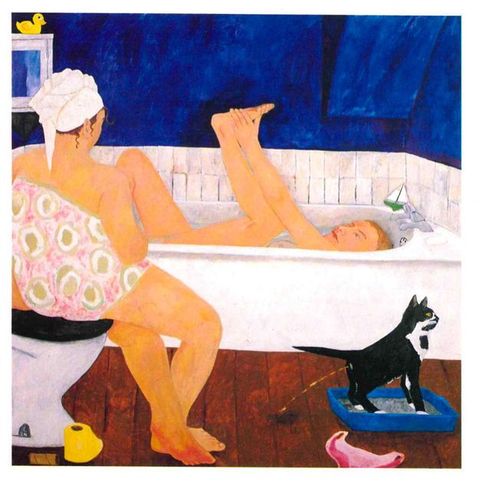
RF: It’s lovely that you responded to that painting. It’s one of my favourites. Unfortunately, it was sold in 1991 and I don’t know where the hell it is now.
But I was seeing all these gay English artists like David Hockney having a nice time in Los Angeles. The painting is my lesbian response to his Domestic Scene, Los Angeles (1963) and his pool paintings. It’s our bathroom. Nenagh’s in the bath, and I’m sitting on the toilet like it’s a throne, and our cat Beanie is pissing outside the litter box. So it’s got piss, maybe shit if you kind of relate to the toilet, but it’s not got blood in it [laughs]. It’s a response to Hockney’s depictions of luxurious Los Angeles gay splendour, with the realities of lesbian life in our flat in Whalley Range.
It’s vibrantly coloured, like most of my work. In fact, I can’t stand artists like Lucian Freud who make everything look very grey. And I have been asked, “How do you get that colour?” I think there’s lots of colour in people. I used to see the paint as the flesh of the painting, and then when I used to mix it with turps [turpentine], that was like the blood.
SJF: When I was asked to respond to the legacy of Real Lemon: Broadening Out, I was immediately drawn to Domestic Scene. Derek and Alice had been researching for the exhibition and uncovered the beautiful full-colour catalogue for your exhibition. I was overjoyed when Derek handed it to me over coffee. He explained that during their research they had tried to track you down to secure your participation in the exhibition but had not been able to find you—so they commissioned me to make a new quilt that responded to, and honoured, the legacy of your groundbreaking exhibition.
The project was a perfect fit for me, having just finished my doctoral studies, which established my quilt-making practice as an affective methodology for revisioning lesbian archive material. But, even more fortuitously, I did manage to find you that very same evening (with the help of a friend, the curator Thomas Dukes). And you are only five minutes down the road from me, with mutual friends. How we hadn’t managed to meet before, I will never know!
RF: I’d been underground for ages, working as an artist in a nightclub and not working in mainstream art. And I had been massively depressed and not making any art for a long while. You found me just by chance because I’d worked with Castlefield Gallery, Manchester, on an over-fifties support programme called bOlder.
SJF: Yes, it was very lucky! It was a bit of a strange process because I had the catalogue before we met. I already knew that I wanted to do a contemporary re-visioning of Domestic Scene Whalley Range, with me and my partner, Talin, in our bathroom in Chorlton, which is the next-door area in south Manchester (fig. 4). I had a real urge to make my own new imagery, after working with so much archival imagery and photography over the course of my PhD. The quilt became a mirror—thirty years on, but just down the road. Although—weren’t you a lot younger than I am now when you painted yours?
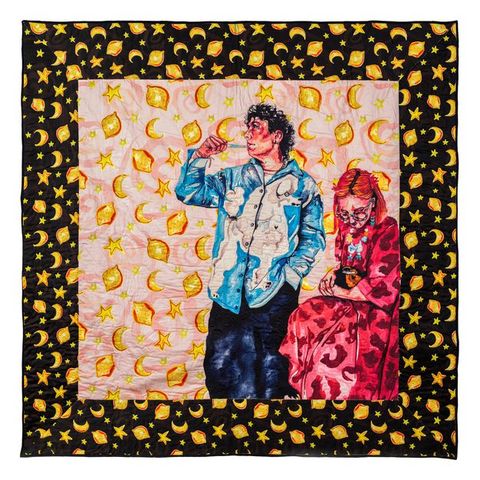
RF: Yeah, I was only about twenty-three when I did the exhibition, so I was a total youngster.
SJF: That’s incredible—such an enormous undertaking for someone so young! So, I wanted to photograph my own reference imagery for my bathroom scene. But I didn’t have a camera tripod so I screwed my phone into my embroidery hoop stand, and got Talin in the bathroom. We also have two cats—Hank and Phoebe—as well as a litter tray by the bath, which Phoebe often misses, so we’ve also often got a puddle of cat piss next to the litter tray! We were getting ready to leave the house: I am sat on edge of the bath holding our guinea pig, Baby Puff, in my lap, while Talin brushes her teeth.
RF: And it’s surrounded by lemons—harking back to my work—which is so beautiful. Thank you so much for doing the piece.
SJF: Oh, it was a pleasure! The lemons are tumbling with stars and moons as well, in reference to your painting Cuckoos (1989), gesturing towards a visual lineage of lesbian iconography from your work to mine (fig. 5).
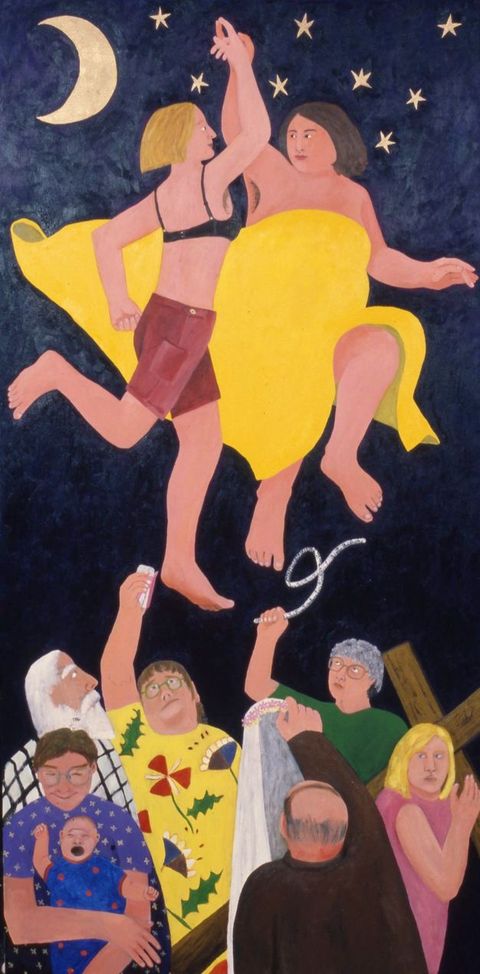
RF: I also look at gay artists from the past and reinterpret them. Real Lemon, Crazy Hand Jive (1991) references Michelangelo’s Creation of Adam (circa 1508–12), as well as the title painting, Real Lemon (1990), a self-portrait where I am wearing a purple leotard with a lemon on my chest, which also references Michelangelo. I had a book that really influenced me called The Nude Male, which looks at the way men have been reproduced in the naked form.1 And I thought they’ve been treated in a much more powerful and dynamic way than the female form in art, so I used to take those images and reinterpret the figures as women.
1SJF: Another bathroom featured in the Real Lemon catalogue that caught my eye was your installation You Ought to Be Hosed Down, which was part of On the Throne, a joint installation piece that you created with Nenagh for Castlemilk Womanhouse in Glasgow in 1990 (fig. 6).
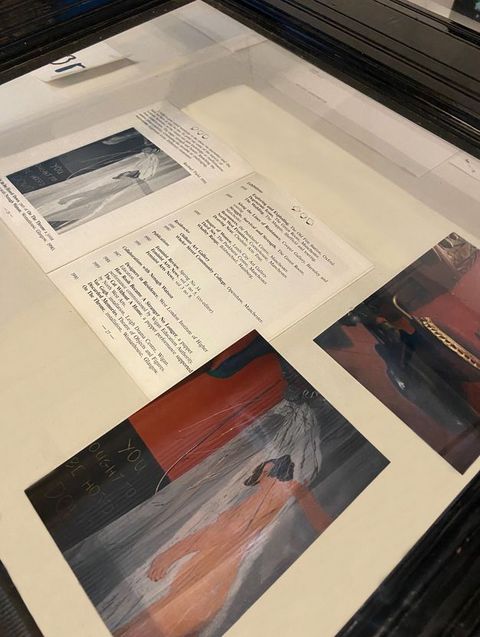
RF: Yes—we took over a bathroom and turned it into a lesbian cathedral. It was based on the Lady Chapel in Chester Cathedral. It included a shower installation with a shower curtain painted with me and Nenagh having a shower together, while the water coming from the shower head was made of wire and nails. It is named after an incident when we were on a gay rally, marching against Section 28 through Stockport in Manchester, and this woman came out of her attic window and shouted at us, “You ought to be hosed down!”
SJF: What was the Womanhouse in Glasgow?
RF: It was a Women in Profile project, where women artists took over a vacant tenement house in Castlemilk.2 Professional women artists (like us) worked alongside women and children from Castlemilk in the summer of 1990. We got a room each and ours was the prettiest [laughs], and people used to like our toilet because we painted it gold and cushioned it all over with velvet.
2SJF: Fabulous! This work really inspired Domestic Scene in Chorlton too, so in the exhibition the quilt was hung over a bath—John Bright’s bath, actually. He was a Rochdale industrialist and politician in the nineteenth century, and there is even a statue of him outside the gallery, connecting the work to the site specificities of Rochdale. Adjacent to the bath was a specimen table curated with archival materials that I had selected from the Rochdale Local Studies and Archive, including original letters between yourself and Jill, original drawings, and colour photographs from Womanhouse, as well as correspondence documenting Jill’s attempts to find galleries where the show could tour, including Camden Art Centre, Bernard Jacobson Gallery, Ikon Gallery, Graves Art Gallery, Institute of Contemporary Arts (ICA), Ferens Art Gallery, the Bluecoat, Tate, Laing Art Gallery.
RF: Yeah, that was quite tough. It only toured to the Pavilion in Leeds.
SJF: So, then, Pavilion was a women’s photography centre founded in 1983 by three Leeds fine art graduates (the same undergraduate degree I did): Dinah Clark, Caroline Taylor, and Shirley Morena. But since 1993 it’s no longer been a women’s centre staffed by women as it became a generalised “visual arts organisation”. These archive materials highlight the lack of support for outwardly lesbian artwork.
RF: But also figurative work, which was less fashionable.
SJF: Right, because you told me that the term was also about “broadening out” the kinds of lesbian artistic methodologies that were visible. At the time did you feel that documentary practices in lesbian art were over-represented?
RF: Yeah, I just really wanted to work against the photographic. I want to see the hand doing things. I don’t want to be sucking on a computer. It’s like a dummy for people to think they’re working; I want the human hand to splish splash around with paint.
SJF: And, from the archive, it seems like it was feminist curators that were supporting your work, for example your exhibition The Third Sex (1989) at the Pankhurst Centre in Manchester.
RF: Yeah, that was the eighties. That was a neat little show. That was mostly my drawings and watercolours. I did some fantastic pictures of Nenagh—she used to be my muse—and she didn’t like posing very much so I had to get used to painting her without looking at her.
SJF: And you were very invested in questioning and broadening out this idea of lesbian representation in art, and really challenging the barriers facing lesbian artists, highlighted in the Lesbian Issue of Feminist Art News that you edited with Jenny Painter in 1991. In the article “Lesbian Shock Culture: Censorship and Misrepresentation of Lesbian Art” you talked about the impact of Section 28 on lesbian artists. It wasn’t just about active censorship of early lesbian work but about erasure by omission and the complete neglect of lesbian artists.3
3RF: Well, if you think of public galleries, they really want a family audience and my work was seen as not family friendly, so that’s one of the reasons it didn’t get much support.
SJF: I think there’s a lot to be done in terms of acknowledging and undoing that kind of erasure and neglect of lesbian artists, which is why it is so important to be shining a light on your work now. More broadly, I think we are still feeling that lack of lesbian artists, particularly those who identify publicly as lesbian or who tackle lesbian themes and topics in their work. Lesbian artists are still hugely under-represented by galleries and collections—something that needs to be actively challenged.
Even as queer art more generally has become more acceptable and popular in gallery programming, there is still a lot to be addressed in terms of what is deemed “acceptable” queer art and what voices are and are not included on gallery walls.
And, for me, the fleeting and ephemeral nature of much queer programming within institutional galleries and museums indicates a lack of real investment in queer artists, who are often unpaid or underpaid—utilised on a temporary basis often around LGBT history month or Pride to suit the funding and marketing narratives of the institution. Queer artists need more than this—they need meaningful financial investments alongside institutional acquisitions that can begin to change the shape of the institution more deeply.
RF: Well, particularly lesbian art. I don’t know if it is too controversial to say this, but gay male work seems to be promoted much more than lesbian work.
So, what was your experience of the exhibition A Tall Order, and revisiting this part of your artistic career—and life—through the archive, as a historical document?
RF: I was just totally overwhelmed. It was like stepping back in time and seeing people I’d worked with at Feminist Art News, seeing how we have all changed. So, it was kind of sad, overwhelming, and slightly embarrassing, but that’s the private view. When I went back to see it with friends, I was a little more relaxed and enjoyed it much more.
It is kind of freaky to think how good you bloody were at that time. It made me wish I had just painted all my life, but I haven’t.
SJF: So, your artistic career does not fit into a straightforward or linear narrative?
RF: I spent a long time creating live/performance art in the company doo-cot, which I co-founded with Nenagh Watson in 1989. We were an organisation regularly funded by the Arts Council, and we produced many touring theatre projects. This led to my working in the digital arts, creating films and images that were part of doo-cot performances and were also exhibited in their own right. Consolidating this development, I undertook an MSc in electronic imaging in 2000–2001, and I got a distinction.
More recently, I have enjoyed being artist-in-residence for the queer nightclub Bollox, live-painting the people in the club, totally away from the mainstream art scene. I’ve only stepped back into it recently and it’s quite terrifying, to be honest with you.
SJF: Making art and putting it out there can be really terrifying. And it’s hard to talk about the artwork without considering the emotional, material, and financial conditions of making it. But I think that’s what is often missing from our narratives of art history.
That was something I wanted to highlight with the archival cabinet in A Tall Order—to highlight Jill’s difficult work of trying to find touring venues for the exhibition. It is a record of huge achievement but also those hard-to-talk-about things that litter an artist’s or curator’s life: rejection, failure, and loss.
And on the theme of the legacy of Real Lemon: Broadening Out, I wanted to ask you what happened to the artworks in the exhibition?
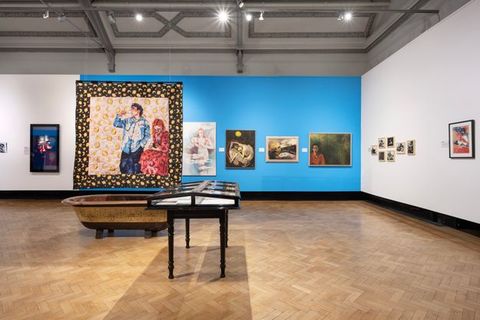
RF: They’re all in my parents’ garage. And it’s quite worrying because the house is going to be sold soon—I have to deal with them, and I don’t know where to store them. I’m thinking of getting rid of quite a lot of the big works. I would advise younger artists not to work too big— unless you can fold them up, which is the joy of your work.
SJF: Well, I am still managing to fill our house up with quilts, stuffed into IKEA bags to keep the cats out.
RF: Yeah. So, obviously it shows my youth and naivety …
SJF: Your ambition.
RF: Yeah.
SJF: And your pleasure and joy in painting and making the lesbian everyday monumental, which is hugely important.
RF: Yes, it was important. I should be proud of that exhibition.
SJF: You should be! And I think that banal problem of storage is indicative of what a lot of marginalised artists have been experiencing, those who do not have gallery representation or bodies of work in institutional collections: houses full of their own archives struggling for space. As people age, they hit a crisis point, which puts our lesbian and feminist art histories at risk. We need more of a concerted effort to collect and protect lesbian work in collections or archives, but in our current funding crisis in the arts this is really difficult.
The scale of your work was important: you were refusing to make yourself small and manageable. And, in terms of your own archive, this is something that we are working on together now—a hugely important long-term project. It was one of your smaller paintings from Real Lemon that was exhibited in A Tall Order: Stepping into My Shoes (fig. 8).
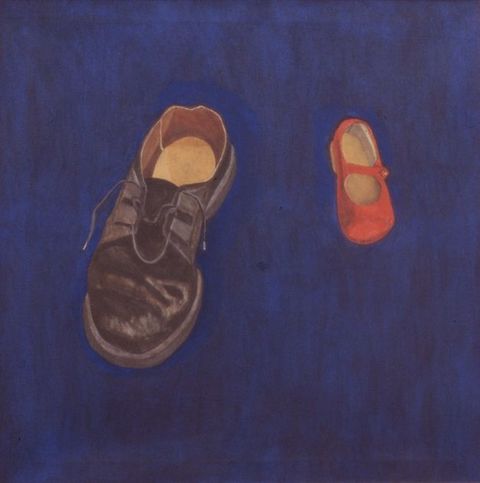
RF: It’s on a blue background. I’ve painted my little girl’s sandal and then I’ve painted a big man’s shoe. Because that’s what I used to wear—men’s shoes. So, it’s dealing with gender identity: how I was growing up with my little red sandals and how I lived in my man shoes. Although I’m not very butch, I used to wear men’s clothing.
SJF: Well, the sensible shoes are an icon of lesbian culture, so it felt very appropriate to have that in the exhibition! It connects to your writing in Feminist Art News on the idea of lesbian tradition and the importance of lesbian identity in your work.6 I know these ideas speak to a very particular moment in your practice, so how does it feel to reflect back on them now?
6RF: Yeah, I was looking backwards as well as forwards to create a new tradition. With my drawing The Third Sex, this is very clear. I depicted myself as a small devil, a reference to the idea of the third sex, which was prevalent in the Weimar era.
And my work is quite traditional in some ways, in its figurative harking back to religious art and icons. Because that was the beginning of art as a communication, art as a propaganda, art as a living film. That’s why I like religious icons: because they communicate.
SJF: And in that backward turn you were seeking a visual language for articulating lesbian experience and identity outside of photographic representation. This search for a lesbian visual language has also been a driving force in my practice and PhD research. And, when I encountered your paintings and read your writing, it felt like finding what I had been searching for.
I worried about what that meant in making work in conversation with you, about mirroring your painting practice. But, actually, I think that mirroring is really important in lesbian culture, especially within such a hostile cultural landscape, which has led to a dearth of lesbian art and culture. We echo across time, reflecting and repeating as an insistence on creating these traditions for ourselves, and in our reiterations we are gesturing towards more—towards abundance.
RF: Queer icons are about educating people. Some people don’t know who Divine is, who Leigh Bowery is, who Pete Burns is, who Radclyffe Hall is, who Gertrude Stein is. So, I am tapping into the lesbian and gay tradition with the portraits I am working on now.
SJF: And you are my queer icon!
I think that’s one of the joys and pleasures of art for me: It isn’t only about what you are representing in the work but about literally creating connection and community. I think we forget sometimes just how important everyday representation in museums and media is, how life-saving it can be for people. It’s a sense of connecting threads running between people, across space and time—a tug to remind you that you are not alone. My work is all spun from this yearning for connection and desire to be a part of a community of care, love, and joy—as well as supporting one another through trauma. And that is what lesbian tradition means to me, weaving ourselves into this lineage. It is an urgent call. It was urgent in the nineties and it is urgent still—now.
And this is why it is so important to acknowledge the significance of Real Lemon, as well as your writing on lesbian censorship and tradition, and co-editing the Lesbian Issue of Feminist Art News. There are so few books written on lesbian art and none exclusively dedicated to the full range of lesbian art in Britain: Cherry Smyth’s hugely important book Damn Fine Art: By New Lesbian Artists does not cover only British artists, and Tessa Boffin and Jean Fraser’s Stolen Glances focuses on photography and is also not only British-oriented.7 What you did, your dedication to lesbian representation and excellence under the restrictive circumstances of Section 28, is hugely important in lesbian, queer, and British art histories. And you were so vulnerable, insisting on being recognised as a lesbian artist.
7RF: Yes, it wasn’t an easy life. It wasn’t easy to present ourselves in the art world because people thought we only got on sometimes because of our sexuality, which was absolute rubbish because we were put down because of our sexuality. It has not been an easy life. I mean, being a woman artist is bad enough—being a lesbian artist is twice as bad.
SJF: And that is why we need each other. I am so glad to have found this friendship with you, and to be inspiring each other and planning future collaborations.
RF: Yes! I am working with you on a performance for your exhibition RABBIT at Bury Art Museum this May through to August 2024.
SJF: And on lots more exciting things to come!
Acknowledgements
This conversation, our collaboration and our friendship were made possible by the diligent, thoughtful, and hugely significant work of Dr Derek Horton and Dr Alice Correia as part of the project A Tall Order!. Thank you for bringing us together. Thank you to my wife, Talin Aghanian, for help with the transcription and for her ongoing, endless support for both me and Rachael.
About the authors
-
Rachael Field is an artist based in Whalley Range, Manchester, who describes herself as “fat, gay, and mad”, and these themes are often addressed in her paintings. Since 2006, she has returned to a solo practice focusing on painting whilst also building a strong collaborative presence in queer activism. Prior to this she was creative director of doo cot, a multimedia performance company that she co-founded in 1986 and jointly ran until its demise in 2006. Previously she was a member of the bOlder programme at Castlefield Gallery, and a studio member at Pool Arts. Field is currently working on collating her archive collection at Bishopsgate Institute in London with Sarah-Joy Ford. This work is funded through a Paul Mellon Curatorial Research Grant. In September 2025 she will begin a visiting research fellowship (jointly held with Sarah-Joy Ford) in the School of Fine Art, History of Art and Cultural Studies at the University of Leeds to support their collaborative work. The pair will have an exhibition at Touchstones, Rochdale in 2028.
-
Sarah-Joy Ford is a Todmorden-based artist and independent scholar working with quilting to explore the complexities and pleasures of lesbian, feminist, and queer communities, histories and archives. Solo exhibitions include Rabbit at Bury Art Museum 2024, HARE at Bobinska Brownlee Gallery 2023 (London), Looking for Lesbians at ONE Gallery 2022 (Los Angeles), Beloved at Plas Newydd Historic House and Gardens 2022 (Llangollen). Her artistic work is represented by Cassinelli Mills. She was the recipient of an NWCDTP award for her PhD research examining quilting as an affective methodology for re-visioning British lesbian archive, at Manchester School of Art. Her solo show dykeland is at the Whitaker (Rossendale) 4 June–21 September 2025. She is a curatorial researcher in lesbian art history at Bishopsgate Institute funded by the Paul Mellon Centre, and visiting research fellow in the School of Fine Art, History of Art and Cultural Studies at the University of Leeds, jointly held with Rachael Field (2025–28). Ford sits on the National Executive Committee for Artists’ Union England.
Footnotes
-
1
Margaret Walters, The Nude Male: A New Perspective (Harmondsworth: Penguin Books, 1979). ↩︎
-
2
Women in Profile’s “Womanhouse” was organised by Rachael Harris, Julie Roberts, and Cathy Wilkes. Information about the project and details for accessing its archive at the Glasgow Women’s Library are here: https://womenslibrary.org.uk/discover-our-projects/house-work-castle-milk-woman-house/about-castlemilk-womanhouse. ↩︎
-
3
Rachael Field, “Lesbian Shock Culture: Censorship and the Misrepresentation of Lesbian Art”, Feminist Art News 3, no. 8 (1991): 9–12. ↩︎
-
4
Kate McMillan, Representation of Female Artists in Britain During 2019 (London: Freelands Foundation, 2018), https://freelandsfoundation.imgix.net/documents/Representation-of-female-artists-2019-Clickable.pdf. ↩︎
-
5
See Catherine Grant, “Fans of Feminism: Re-writing Histories of Second-Wave Feminism in Contemporary Art”, Oxford Art Journal 34, no. 2 (2011): 265–86; Laura Guy, “Wanting Pictures After Feminism: Re-reading On Our Backs”, Women: A Cultural Review 30, no. 3 (2019): 319–41; Jonathan D. Katz, Erin Silver, and Amelia Jones. “Our Maiden Aunt, Lesbianism, or the Limits of Queer”, in Otherwise: Imagining Queer Feminist Art Histories, ed. Amelia Jones and Erin Silver (Manchester: University of Manchester Press, 2016), 72–92; M. H. Thompson, “Introduction: Lesbian Art and Art by Lesbians”, Journal of Lesbian Studies 14, nos. 2–3 (2010): 119–23. ↩︎
-
6
Rachael Field, “Lesbian Tradition”, Feminist Review 34 (1990): 115–19. ↩︎
-
7
Cherry Smyth, Damn Fine Art: By New Lesbian Artists (London: Cassell, 1996); Tessa Boffin and Jean Fraser, eds., Stolen Glances: Lesbians Take Photographs (London: Pandora Press, 1991). ↩︎
Bibliography
Boffin, Tessa, and Jean Fraser, eds. Stolen Glances: Lesbians Take Photographs. London: Pandora Press, 1991.
Field, Rachael. “Lesbian Shock Culture: Censorship and the Misrepresentation of Lesbian Art”. Feminist Art News 3, no. 8 (1991): 9–12.
Field, Rachael. “Lesbian Tradition”. Feminist Review 34 (1990): 115–19.
Field, Rachael, and Jenny Painter, eds. “Lesbian Issue”. Special issue, Feminist Art News 3, no. 8 (1991).
Grant, Catherine. “Fans of Feminism: Re-writing Histories of Second-Wave Feminism in Contemporary Art”. Oxford Art Journal 34, no. 2 (2011): 265–86.
Guy, Laura. “Wanting Pictures After Feminism: Re-reading On Our Backs”. Women: A Cultural Review 30, no. 3 (2019): 319–41.
Katz, Jonathan D., Erin Silver, and Amelia Jones. “Our Maiden Aunt, Lesbianism, or the Limits of Queer”. In Otherwise: Imagining Queer Feminist Art Histories, edited by Amelia Jones and Erin Silver, 72–92. Manchester: University of Manchester Press, 2016.
McMillan, Kate. Representation of Female Artists in Britain During 2019. London: Freelands Foundation, 2018. https://freelandsfoundation.imgix.net/documents/Representation-of-female-artists-2019-Clickable.pdf.
Smyth, Cherry. Damn Fine Art by New Lesbian Artists. London: Cassell, 1996.
Thompson, M. H. “Introduction: Lesbian Art and Art by
Lesbians”. Journal of Lesbian Studies 14,
nos. 2–3 (2010): 119–23.
Walters, Margaret.
The Nude Male: A New Perspective.
Harmondsworth: Penguin Books, 1979.
Imprint
| Author | |
|---|---|
| Date | 14 July 2025 |
| Category | Interview |
| Review status | Peer Reviewed (Double Blind) |
| License | Creative Commons Attribution-NonCommercial 4.0 International (CC BY-NC 4.0) |
| Downloads | PDF format |
| Article DOI | https://doi.org/10.17658/issn.2058-5462/issue-27/rfieldsjford |
| Cite as | Ford, Sarah-Joy, and Rachael Field. “Real Lemon: An Intergenerational Dialogue on Lesbian Tradition.” In British Art Studies: Queer Art in Britain since the 1980s (Edited by Fiona Anderson, Flora Dunster, Theo Gordon and Laura Guy), by Fiona Anderson, Flora Dunster, Theo Gordon, and Laura Guy. London and New Haven: Paul Mellon Centre for Studies in British Art and Yale Center for British Art, 2025. https://doi.org/10.17658/issn.2058-5462/issue-27/rfieldsjford. |
